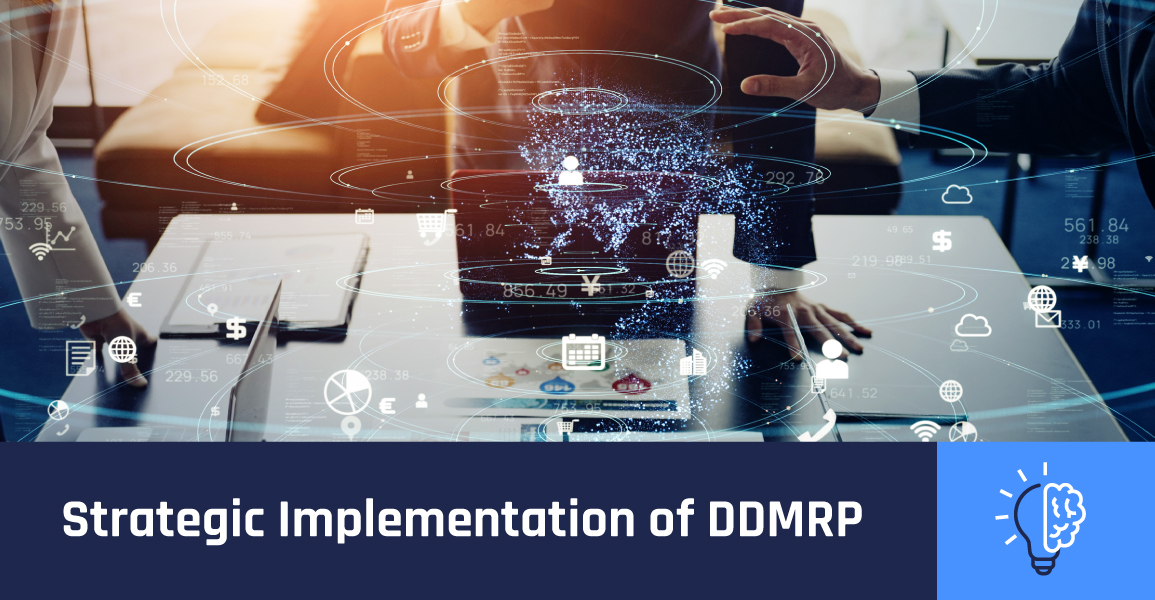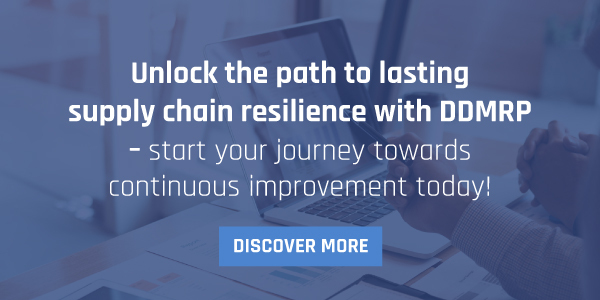
The Agile Advantage: How DDMRP Transforms Supply Chains for Competitive Edge
March 18, 2024
Harmony in Motion: How DDMRP Drives the Symbiosis of Agility and Sustainability
March 29, 2024In the contemporary business environment, marked by volatility, uncertainty, complexity, and ambiguity (VUCA), large enterprises are incessantly in pursuit of methodologies and frameworks that not only enhance operational efficiency but also infuse agility and innovation across their supply chains. Demand Driven Material Requirements Planning (DDMRP) emerges as a formidable strategy in this quest. This comprehensive article delves into the nuances of implementing DDMRP at scale within large organisations, aiming to unravel how this approach can revolutionise supply chain management by injecting unprecedented levels of flexibility and innovation.
Understanding DDMRP
Understanding the intricacies of Demand Driven Material Requirements Planning (DDMRP) is foundational for any organisation looking to innovate and improve agility within its supply chain. At its core, DDMRP represents a transformative approach, adept at navigating the uncertainties and complexities prevalent in modern supply chains. This methodology is not just a tool but a comprehensive strategy that integrates the principles of Material Requirements Planning (MRP), the Theory of Constraints (TOC), and Lean Manufacturing. The synergy of these concepts under the DDMRP framework provides a robust solution to the perennial challenges of market volatility and supply chain disruptions.
The essence of DDMRP lies in its strategic inventory positioning and the establishment of dynamic buffer levels. Unlike traditional planning systems that primarily rely on forecast-driven models, DDMRP adopts a demand-driven approach, focusing on actual market demands to guide inventory replenishment and production. This shift from forecasting to visibility allows companies to operate with a higher degree of precision and responsiveness.
The Need for DDMRP in Large Enterprises
The imperative for Demand Driven Material Requirements Planning (DDMRP) in large enterprises cannot be overstated. These behemoths of industry operate within an intricate web of global supply chains, characterised by extensive geographical reach, a multitude of suppliers, and a diverse array of partners. Such complexity breeds challenges that traditional planning methodologies often falter against. Long lead times, inventory mismatches, and rigidity in operations are but a few of the obstacles that can stymie efficiency and responsiveness in a large enterprise’s supply chain, leading to decreased customer satisfaction and potential loss of market share.
In this labyrinthine setting, DDMRP emerges as a beacon of innovation and agility. Its core appeal lies in its ability to transform these extensive and complex supply networks into more streamlined, responsive entities. By adopting a demand-driven approach, DDMRP enables large enterprises to break free from the constraints of forecast-based planning systems, which are notoriously unreliable in predicting the volatile demands of today’s global markets. Instead, DDMRP focuses on actual demand signals to guide replenishment and production, significantly reducing the risks associated with inventory excesses or shortages.
Strategic Implementation of DDMRP

Assessing Organisational Readiness
Assessing organisational readiness before implementing DDMRP is critical for a successful transition. This involves conducting a thorough evaluation of current supply chain operations to identify existing pain points and inefficiencies. By understanding the organisation’s current state, leaders can pinpoint areas where DDMRP can make the most significant impact.
Moreover, assessing readiness entails recognizing the cultural and structural changes necessary for DDMRP adoption. Shifting away from traditional planning methods towards a dynamic, demand-driven approach requires a fundamental change in mindset and operational practices. Leaders must ensure that employees are prepared for this shift and are willing to embrace new methodologies.
Leadership commitment is paramount throughout this process. Executives must champion the adoption of DDMRP, setting the tone for the organisation and inspiring a culture of agility and innovation. Their support signals to employees that the transition is a priority and that resources will be allocated to facilitate a smooth implementation. Ultimately, by thoroughly assessing organisational readiness, leaders can pave the way for a successful integration of DDMRP, positioning the organisation for long-term success in an increasingly dynamic marketplace.
Training and Education
The cornerstone of successfully integrating Demand Driven Material Requirements Planning (DDMRP) into large enterprises lies in a comprehensive training and education program. Such a program is pivotal, not merely for the dissemination of theoretical knowledge but for the practical application of DDMRP principles and tools as well. It’s about transforming the abstract into tangible actions and decisions that drive the supply chain forward with agility and precision.
Training should be designed to cater to various levels within the organisation, ensuring that from the executive suite to the operational floor, everyone understands their role in the DDMRP ecosystem. This involves not just a one-time training session but a continuous educational journey that keeps pace with evolving DDMRP practices and the dynamic nature of supply chains.
Investment in ongoing education underscores the organisation’s dedication to the DDMRP methodology, reinforcing its importance and fostering a culture of continuous improvement. By equipping employees with the skills and knowledge necessary to implement and sustain DDMRP, organisations not only smooth the transition but also lay the groundwork for leveraging DDMRP to its fullest potential, ensuring long-term operational success and competitive advantage.
Phased Roll-Out
Implementing DDMRP across large enterprises demands a meticulous approach, making a phased roll-out strategy imperative. By commencing with a pilot project in a specific product line or geographic region, organisations can gauge the effectiveness of DDMRP within a controlled environment. This initial phase serves as a testing ground, allowing for the identification of potential challenges and roadblocks that may arise during broader implementation.
The phased approach enables organisations to iteratively refine their DDMRP implementation based on the lessons learned from the pilot phase. This iterative process of testing, learning, and adjusting fosters continuous improvement and optimization, ensuring that subsequent roll-out phases are more streamlined and effective.
Moreover, by starting with a limited scope, organisations can minimise disruption to ongoing operations while providing sufficient focus and resources to ensure the success of the pilot project. This gradual expansion of DDMRP implementation across different product lines or regions allows for a more methodical and controlled transition, ultimately increasing the likelihood of success and maximising the benefits of DDMRP across the entire enterprise.

Technology Integration
Technology serves as the backbone of successful DDMRP implementation in large enterprises, offering the necessary tools to effectively manage complex supply chains. Investing in the right software solutions that align with DDMRP principles is paramount for success. These solutions should provide capabilities for strategic inventory positioning, enabling organisations to optimise inventory levels across multiple locations and tiers of the supply chain. Dynamic buffer adjustments allow for real-time response to changes in demand or supply, ensuring optimal inventory levels and minimising the risk of stockouts or excess inventory.
Furthermore, real-time visibility across the supply chain is essential for effective decision-making. Integrated software solutions enable organisations to track inventory movements, monitor demand signals, and identify potential bottlenecks or disruptions. Integrating these tools with existing ERP systems can be challenging but is essential for achieving seamless information flow and ensuring data accuracy and consistency.
By leveraging technology effectively, organisations can enhance their agility and responsiveness, enabling them to adapt quickly to changing market conditions and customer demands. Ultimately, this drives greater efficiency and competitiveness, positioning the organisation for success in the dynamic and fast-paced business environment.
Challenges and Solutions

Cultural Resistance
Cultural resistance poses a significant challenge to the successful implementation of DDMRP. Employees, ingrained with traditional planning methodologies, may exhibit scepticism or reluctance towards embracing a new, dynamic approach like DDMRP. This resistance is not merely a reluctance to change but often stems from a lack of understanding of the benefits and functionalities of DDMRP compared to traditional systems.
Overcoming this cultural hurdle necessitates a multifaceted strategy. Strong leadership plays a crucial role in this transition, with leaders needing to champion the shift towards DDMRP, articulating its benefits clearly and consistently. They must set the vision and provide the necessary support to facilitate change, demonstrating commitment to the new approach.
Ongoing education and training are pivotal in addressing scepticism and building confidence in DDMRP methodologies. By equipping employees with knowledge and skills, organisations can foster a deeper understanding of how DDMRP can improve supply chain performance and responsiveness.
Furthermore, implementing pilot projects can serve as tangible proof of concept, showcasing the real-world benefits of DDMRP. Success stories from these pilot initiatives can help in mitigating resistance by providing concrete examples of improved efficiency, reduced lead times, and enhanced service levels, thereby building a compelling case for the wider adoption of DDMRP across the organisation.
Complexity of Scale
Implementing Demand Driven Material Requirements Planning (DDMRP) in large enterprises introduces a complexity of scale that requires careful navigation. The challenge lies in deploying a new system across diverse departments and geographies without hindering the day-to-day operations that are crucial for the organisation’s survival. This task demands not just a strategic vision but also meticulous operational planning and coordination.
To effectively manage this complexity, it is advisable for enterprises to constitute a dedicated team tasked specifically with overseeing the DDMRP implementation. This team should be composed of members with a deep understanding of DDMRP principles, as well as insights into the organisation’s unique supply chain challenges and dynamics. Armed with a clear roadmap and the requisite authority to make strategic decisions, this team can act as the central nerve centre, coordinating efforts across different segments of the organisation, ensuring alignment with the overarching objectives, and adjusting strategies in response to emerging challenges.
The dedicated team’s role is crucial in bridging the gap between the theoretical benefits of DDMRP and its practical, real-world application across the vast and varied landscape of a large enterprise, ensuring a smooth transition that capitalises on the agility and efficiency promised by DDMRP.
Data Integrity and Quality
Data integrity and quality are paramount for the successful implementation of Demand Driven Material Requirements Planning (DDMRP) within large enterprises. The accuracy and timeliness of data feeding into DDMRP systems directly influence the effectiveness of decision-making processes and the overall performance of the supply chain.
To ensure data integrity and quality, large enterprises must invest in robust data cleansing and governance initiatives. This involves systematically identifying and rectifying inconsistencies, errors, and redundancies in the data, ensuring that it is accurate, complete, and reliable. Additionally, implementing governance mechanisms helps establish protocols and standards for data collection, storage, and management, ensuring consistency and compliance across the organisation.
While investing in data cleansing and governance initiatives may require a significant upfront effort, the long-term benefits are undeniable. By maintaining high-quality data, organisations can make more informed decisions, improve forecasting accuracy, and enhance overall operational efficiency. Moreover, reliable data enables organisations to adapt quickly to changes in market conditions, respond promptly to customer demands, and mitigate risks effectively, thereby positioning themselves for sustained success in an increasingly competitive business landscape.
The Road Ahead: Scaling Innovation and Agility
Integrating DDMRP into large enterprises is not merely about enhancing supply chain efficiency; it’s about reimagining how organisations respond to market demands and disruptions. By adopting DDMRP, companies can move from a static, forecast-driven planning model to a dynamic, demand-driven approach. This shift enables enterprises to be more agile and innovative, responding quickly to changes in the market and seizing opportunities as they arise.
The successful scaling of DDMRP in large enterprises depends on a combination of strategic planning, technological investment, and cultural change. While the journey may be complex and challenging, the rewards in terms of improved service levels, reduced lead times, and enhanced competitiveness are compelling.
Conclusion
DDMRP offers a powerful framework for large enterprises seeking to inject agility and innovation into their supply chains. By adopting a demand-driven approach, organisations can better navigate the complexities of today’s global marketplace, responding more effectively to customer needs and market shifts. The journey towards DDMRP at scale involves strategic planning, technological integration, and cultural transformation. Despite the challenges, the potential benefits in terms of operational efficiency, customer satisfaction, and competitive advantage make DDMRP an invaluable strategy for large enterprises committed to achieving maximum agility.
Empower your large enterprise with the agility of DDMRP. Get in touch today!





